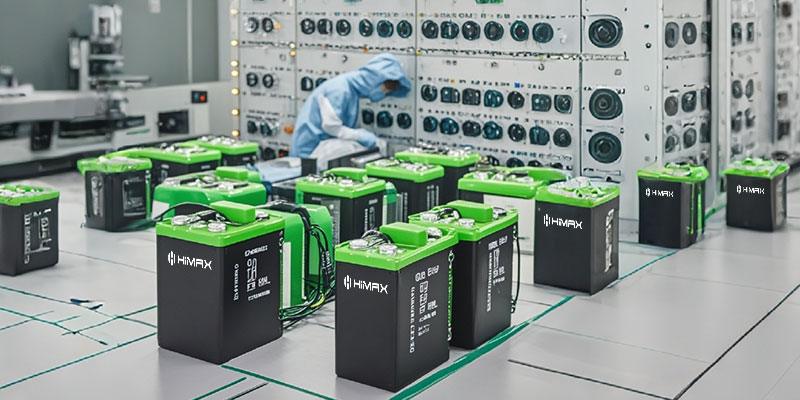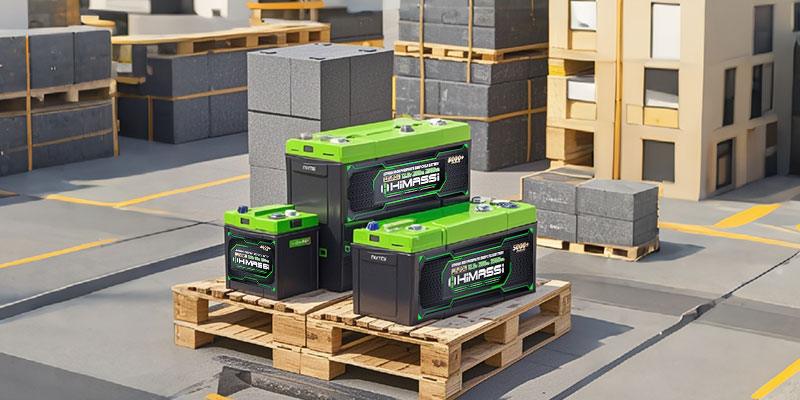Top Trends in Lithium Battery Trading for 2024
Introduction
The global lithium battery market continues to evolve at a rapid pace, driven by advances in technology, shifts in global policies, and growing demand for sustainable energy solutions. With electric vehicles (EVs), renewable energy storage, and portable electronics becoming more prevalent, understanding the latest trends in lithium battery trading is essential for businesses, investors, and industry professionals. In this article, we explore the top trends shaping lithium battery trading in 2024, providing valuable insights to help businesses navigate the complexities of this dynamic market.
- Rising Global Demand Driving Expansion of the Lithium Battery Supply Chain
The demand for lithium batteries continues to soar globally, with electric vehicles and energy storage systems leading the charge. According to industry forecasts, the global lithium-ion battery market is expected to reach new heights by 2024, driven by a confluence of factors, including the widespread adoption of EVs, the integration of renewable energy sources, and the need for portable power in consumer electronics.
This rising demand has created significant pressure on the global supply chain, which must rapidly expand to meet the growing needs of the market. Key regions such as Asia, particularly China, continue to dominate lithium battery production. However, Western nations are increasing their capacity to reduce reliance on Asian suppliers, diversify their supply chains, and enhance local production capabilities.
Impact on Trading: Businesses involved in lithium battery trading will need to navigate increasingly complex supply chains. Sourcing strategies must consider regional variations in production capabilities, shipping costs, and potential disruptions caused by geopolitical events. Companies that diversify their sourcing from multiple regions will gain a competitive edge by mitigating risks and ensuring a more stable supply.
- Emerging Technologies Boosting Lithium Battery Performance
Advancements in battery technology are transforming the lithium battery industry, with new innovations offering enhanced performance, improved safety, and longer lifespans. Solid-state batteries, which utilize a solid electrolyte instead of a liquid one, are one of the most promising developments. These batteries have the potential to offer higher energy densities, faster charging times, and a significantly reduced risk of overheating or fire.
Similarly, breakthroughs in materials science, such as the development of sodium-ion batteries, could further disrupt the lithium battery market by providing a cheaper and more abundant alternative to lithium-based technologies. While sodium-ion batteries are not yet commercially viable at scale, their potential impact on the market cannot be ignored.
Impact on Trading: Traders and businesses must stay informed about these technological advancements, as they will influence market demand and pricing. Companies investing in next-generation battery technologies, such as solid-state batteries, will likely be at the forefront of the market in the coming years. For traders, understanding which technologies are gaining traction and which are still in the research and development phase is critical for making informed business decisions.

- Sustainability and Recycling Becoming a Major Focus
As the global push for sustainability intensifies, the lithium battery industry faces increasing pressure to adopt more eco-friendly practices. The growing use of lithium batteries in EVs and renewable energy storage has prompted concerns about the environmental impact of battery production and disposal.
Battery recycling is emerging as a critical solution to address these concerns. Governments and industry leaders are focusing on developing efficient recycling methods to recover valuable materials such as lithium, cobalt, and nickel from used batteries. Companies that invest in sustainable practices and efficient recycling technologies are likely to benefit from regulatory support and consumer preference for environmentally responsible products.
Impact on Trading: Sustainability initiatives are influencing market trends and will continue to shape trading dynamics. Traders must be aware of new regulations related to battery recycling and disposal, as compliance will become increasingly important in maintaining access to global markets. Furthermore, businesses that adopt sustainable practices and offer environmentally friendly products will have a competitive advantage in regions with strict environmental standards, such as Europe and the U.S.
- Global Policy and Regulatory Shifts
Government policies and regulations play a crucial role in shaping the lithium battery market. In recent years, numerous countries have implemented policies to encourage the adoption of EVs, renewable energy solutions, and energy-efficient technologies, all of which contribute to the growing demand for lithium batteries.
In the United States, the Inflation Reduction Act has introduced significant subsidies and incentives for the production and purchase of EVs, which is expected to boost demand for lithium batteries. Similarly, Europe continues to advance its green energy agenda with ambitious targets for reducing carbon emissions, further driving the need for energy storage solutions.
China, as a dominant player in the lithium battery market, has set aggressive goals to achieve carbon neutrality by 2060. This has spurred investment in renewable energy technologies, including large-scale battery storage systems.
Impact on Trading: Traders must stay informed about shifting policies and regulations in key markets. Changes in trade tariffs, environmental regulations, and government incentives will have a direct impact on the flow of lithium batteries across borders. Businesses that adapt quickly to these changes and align their strategies with government priorities will be better positioned to capture market opportunities.
- Price Fluctuations and Cost Management
The lithium battery market is characterized by significant price volatility, driven by fluctuations in the cost of raw materials such as lithium, cobalt, and nickel. While the demand for lithium batteries continues to rise, supply constraints and the geopolitical risks associated with raw material extraction pose challenges to stable pricing.
In 2024, it is expected that lithium prices will remain volatile, especially as the demand for EVs and renewable energy storage grows. Traders must account for these price fluctuations when negotiating contracts and setting pricing strategies.
Impact on Trading: Cost management will be a critical focus for businesses in the lithium battery trading sector. Traders need to monitor raw material prices closely and develop strategies for mitigating cost fluctuations, such as entering long-term supply agreements or sourcing from multiple suppliers. Companies that effectively manage costs will be able to maintain competitive pricing and secure their position in the market.
- Supply Chain Security and Regional Distribution
The COVID-19 pandemic highlighted vulnerabilities in global supply chains, and the lithium battery market was no exception. Disruptions in shipping, production, and logistics during the pandemic underscored the need for supply chain diversification and security.
In response, many companies are implementing strategies to create more resilient supply chains, such as establishing regional production hubs and reducing reliance on a single supplier or country. This trend is expected to continue in 2024, as businesses prioritize supply chain security to mitigate risks from future disruptions.
Impact on Trading: Supply chain security will be a key consideration for traders in the lithium battery market. Businesses that build diverse, resilient supply chains will be better equipped to navigate challenges and maintain consistent access to materials. Regional distribution networks will also become more important as companies seek to reduce shipping costs and shorten lead times.
- Industry Standardization and Certification
As the lithium battery market matures, there is a growing emphasis on industry standardization and certification to ensure product safety, performance, and reliability. Countries and regions are implementing stricter standards for battery production and usage, especially in industries like EVs, where safety concerns are paramount.
For instance, the adoption of international standards such as ISO and IEC for lithium battery safety and performance testing is becoming more widespread. These certifications provide buyers and traders with the assurance that products meet the highest quality and safety benchmarks.
Impact on Trading: For businesses involved in lithium battery trading, complying with industry standards and obtaining relevant certifications is essential for maintaining access to global markets. Products that fail to meet safety or performance standards may face regulatory hurdles, leading to potential losses. Companies that prioritize certification and standardization will be more attractive partners for buyers in regions with strict regulations.
Himax Electronics’ Advantage
Himax Electronics is at the forefront of the lithium battery market, offering cutting-edge solutions tailored to meet the evolving needs of businesses worldwide. With years of experience in the industry, Himax is known for its commitment to quality, innovation, and customer satisfaction.
Our products, including high-performance lithium-ion and LiFePO4 batteries, are designed to meet the highest standards of safety, efficiency, and durability. Whether you are looking for solutions for electric vehicles, energy storage, or industrial applications, Himax Electronics provides the expertise and products necessary to succeed in this competitive market.
By staying ahead of industry trends and continually improving our offerings, Himax Electronics ensures that our customers are equipped to navigate the rapidly changing landscape of lithium battery trading. Partner with Himax Electronics to benefit from our extensive knowledge, global reach, and innovative solutions.

Conclusion
The lithium battery market is poised for significant growth in 2024, driven by advancements in technology, shifts in government policies, and increasing demand for sustainable energy solutions. By understanding the key trends shaping this market, businesses can position themselves to capitalize on emerging opportunities and overcome potential challenges.
As the market continues to evolve, businesses must stay informed about the latest developments in battery technology, sustainability initiatives, and regulatory changes. Those who adapt to these trends will be well-positioned to succeed in the competitive landscape of lithium battery trading.



